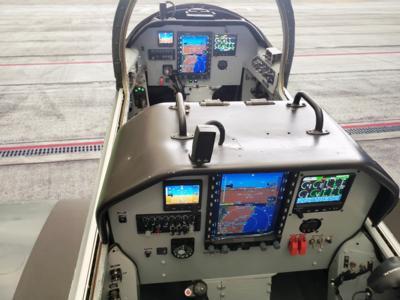Sun, Oct 16, 2022
Military Turboprop Trainer On Track for Genesys Flight Deck Upgrade
Student pilots of the armed services might see some spiffy avionics in their future now that Genesys Aerosystems has obtained an FAA project number to approve their avionics in their T-6 Texan IIs.

The number starts off the process to add the Beech Model 3000/ T-6 Texan II to an existing STC for its Swiss competitor, the Pilatus PC-7. The Texan is in service with a plethora of military training programs around the world and at home as a bridge between traditional general aviation and jet-powered aircraft, giving students a feel for a real high-performance, demanding fighter at an attractive price per flight hour.
The Genesys avionics suite includes all the hits, all the classics when designing a modern panel, with EFIS displays with integrated FMS, TAWS, integrated digital flight recording, and a host of other features for tandem-seat training aircraft. Perhaps best of all, the installation results in an uncluttered, streamlined appearance with a little room to spare on the edges of the panel. A pair of large displays allow for a variety of functions, with backup instruments and a well-placed FMS in easy reach. In designing the avionics suite, Genesys included its Genesys Digital Radio (GDRTM) software-definable integrated VHF & UHF Nav/Comm radio for max interoperability across all operators, in addition to a number of ultra-compact sensors, engine/airframe indications, and integrated radio management. For additional sense of consistency across their future service aircraft, the Genesys includes an integrated voice-warning caution system.
Genesys ensured that the architecture aligns with DoD’s Modular Open Systems Approach (MOSA), which provides operators with long- term sustainment and system growth capability without being locked in to the original OEM for changes. That flexibility makes future changes easy, like modifications to flight symbology in the displays without affecting their FAA TSO. The initial installation is being accomplished in Genesys’ own Pilatus PC-7, the aircraft upon which the PC-9 and Beech Model 3000 are based. The STC is expected to be FAA approved by the first quarter of 2023.
“The similarity of the PC-7, Beech 3000, and T-6A Texan II models lend themselves ideally to an AML STC,” said Dean Boston, Chief Certification Engineer. “This approach allows us to easily modify the design as needed to meet the T-6A’s unique requirements as well as a variety of similar trainer fleets around the world. The high level of software-defined TSO functions dramatically reduces obsolescence associated with discrete electronic devices faced by trainer aircraft today.”
FMI: ??www.genesys-aerosystems.com
More News
Aero Linx: International Federation of Air Traffic Controllers' Associations (IFATCA) IFATCA is the recognised international organisation representing air traffic controller associ>[...]
“The BlackBird is more than a demonstrator—it’s a flying testbed for the future of aviation. To see it take flight in such a short time is a testament to our team>[...]
Glideslope Intercept Altitude The published minimum altitude to intercept the glideslope in the intermediate segment of an instrument approach. Government charts use the lightning >[...]
Also: MQ-9B UAS MTC, FlightSimExpo, New JPL Director, Japanese Lunar Lander Preps Merlin’s flight testing campaign continues to rapidly progress with its certification-ready >[...]
From 2017 (YouTube Edition): The Airplane From Down Under Is A Proven Trainer… Jabiru was one of the early light sport aircraft (LSA) brought into the U.S.A. when the sport >[...]
 ANN's Daily Aero-Linx (05.16.25)
ANN's Daily Aero-Linx (05.16.25) Aero-News: Quote of the Day (05.16.25)
Aero-News: Quote of the Day (05.16.25) ANN's Daily Aero-Term (05.16.25): Glideslope Intercept Altitude
ANN's Daily Aero-Term (05.16.25): Glideslope Intercept Altitude Airborne-NextGen 05.13.25: Merlin Tests, Dronetag Accuses, Flying Car?
Airborne-NextGen 05.13.25: Merlin Tests, Dronetag Accuses, Flying Car? Classic Aero-TV: Jabiru's New J170-D - An Upgraded and Fine-tuned LSA
Classic Aero-TV: Jabiru's New J170-D - An Upgraded and Fine-tuned LSA



